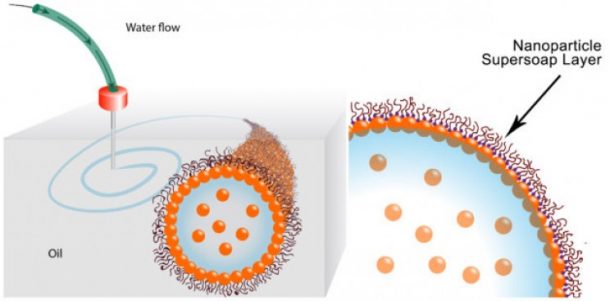A team of researchers from the Department of Energy’s Lawrence Berkeley National Laboratory has recently discovered a new way to print 3D structures made from liquid. The researchers have said that this is the first step towards the creation of liquid electronics which can mold into any shape to be used in stretchable devices. To make the task achievable, scientists have used an off-the-shelf 3D printer. They modified the printer by adding a syringe which will add tiny amounts of water in a small box of silicon oil.
The water which was injected into the printer was seeded with gold nanoparticles. Dispersed polymer ligands were also added to the oil. Ligands are basically a group of atoms which bind to a metal atom. When the gold-flecked water and polymer tainted oil are combined together, the ligands are pulled and bound with the gold nanoparticles. The resultant was a cloak of nanoparticles around the water which was stopping the water from breaking into drops.

The cloak keeps the water into a tube which allows it to be printed by the 3D printer. The researchers have named the concoction a nanoparticle supersoap. This mixture is a “surfactant” and reduces the surface tensions of the liquids when it comes in contact with it. Since we know that water and oil don’t mix, but when dish soap is added to the mixture, the surface tension is reduced and it allows the mix to wash the greasy dishes easily. But unlike dish soap, oil and water when the ligands which are present in the oil and the gold nanoparticles from water meet the result is vitrification. It is the same process which occurs when the molten glass cools down and takes its solid form once again.
Scientists were able to control the shape of the outcome by having these processes captured inside the printer. Russell said, “This stability means we can stretch water into a tube, and it remains a tube. Or we can shape water into an ellipsoid, and it remains an ellipsoid. We’ve used these nanoparticle super soaps to print tubes of water that last for several months.” The results are the first steps in the development of an entirely new kind of electronics. The 3D printed liquids can make the production of flexible and stretchy devices possible.
Tom Russell, a visiting faculty scientist in Berkeley Lab’s Materials Sciences Division, said, “It’s a new class of material that can reconfigure itself, and it has the potential to be customized into liquid reaction vessels for many uses, from chemical synthesis to ion transport to catalysis.” He has developed the method and material in collaboration with Joe Forth who is a postdoctoral researcher in the Materials Science Division as well. Forth said, “We can squeeze liquid from a needle, and place threads of water anywhere we want in three dimensions. We can also ping the material with an external force, which momentarily breaks the supersoap’s stability and changes the shape of the water threads. The structures are endlessly reconfigurable.”


